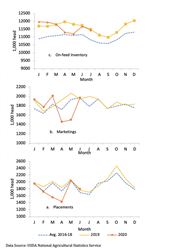|
U.S. Cattle Inventory Stabilizes
FAYETTEVILLE, ARK.
Cattle industry numbers in several categories returned to relative normalcy in June, a bright spot in an otherwise difficult economic year, as the COVID-19 pandemic continues throughout the United States.
Numbers for on-feed cattle inventory, marketings and placements rebounded from comparative slumps to meet same-month figures from 2019, according to an economic impact update published by the University of Arkansas System Division of Agriculture.
“Overall, after dropping sharply in April and May due to a sharp slow-down in placements, the total on-feed inventory has returned to a fairly normal seasonal pattern at a level close to the previous year,” John Anderson, head of the agricultural economics and agribusiness department of the University of Arkansas System Division of Agriculture and the Dale Bumpers College of Agricultural Food and Life Sciences, said.
The economic update is part of an ongoing analysis from the Division of Agriculture, examining the economic impacts of the COVID-19 pandemic on agriculture and other aspects of society in the United States. The original report, along with all updates, can be found at https://bit.ly/AR-Ag-Eco-Impacts2020.
In January and February, U.S. farmers’ “on-feed inventory” – that is, cattle that are nearly ready for slaughter and sale – was actually above 2019 numbers, sitting at nearly 12 million head. March marked a steep drop, falling to about 11.2 million in May – well below the 11.8 million inventory of May 2019. By June, the numbers had rebounded to almost 11.7 million, on track again with the previous year. Both years have remained above the market average established from 2016-2018, which ranged from about 10.6 million to about 11.2 million cattle.
Marketings and placements
However, marketings and placements are where producers rebounded from one of the tougher spring seasons since 2016. Marketings in April plunged to below 1.5 million head of cattle, well below both the 2016-2018 average of 1.7 million and April 2019’s figure’s 1.9 million, before rebounding in June to almost 2 million head, which ties with both 2019 and the 2016-2018 average.
Placements also fell from January’s nearly 2 million cattle (again, a tie for both January 2019 and the 2016-2018 January average) to a low of 1.4 million in April, before rebounding to more than 2 million in May.
“Front-end inventories – those cattle that have been on feed for long enough to be considered essentially market ready – remain large. The number of cattle on feed for 120 days or more dropped in June as marketings rebounded, but they remain almost 20 percent larger than they were a year ago,” according to the report.
In the report, Anderson said that the biggest contributing factor to slower cattle placements in June appeared to be deteriorating pasture conditions, rather than anything directly related to the COVID-19 pandemic.
Anderson said his recent analysis was based on the U.S. Department of Agriculture’s annual mid-year Cattle Inventory Report, which is typically less anticipated that the annual report issued in January. The January report typically delves into state-level inventory numbers, which the mid-year report does not.
He noted that at the beginning of 2020, the U.S. beef industry was already experiencing an expected, cyclical contraction, and that as of July 1, the national beef inventory was about 1 percent lower than at the same point in 2019. The onset of the pandemic, he said, may have actually slowed the contraction, as it became more difficult to actually get cattle slaughtered. ∆

Cattle industry numbers in several categories returned to relative normalcy in June, a bright spot in an otherwise difficult economic year, as the COVID-19 pandemic continues throughout the United States.
Division of Agriculture graphic
|
|